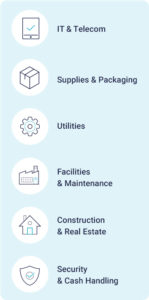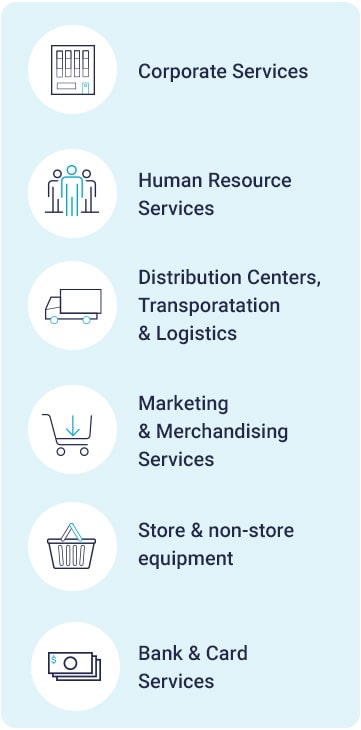Ivalua Named A Leader In The 2025 Gartner Magic Quadrant™ For Source-To-Pay Suites Report
View Report
Ivalua Named A Leader In The 2025 Gartner Magic Quadrant™ For Source-To-Pay Suites Report
View Report
Blog »

di Vishal Patel
Retailers have faced a tough year in the last 12-18 months, and while recovery seems to be in progress, they still have some work to do. During the pandemic, Procurement flexed its muscle, helping to mitigate supply chain disruptions and enable new channels for engaging with customers and fulfilling orders. Procurement teams will continue to play a significant role in helping retail businesses find their footing as they not only commit to new ways of doing business, but look to optimize spend, cut costs, and drive revenue.
Here are four ways leading Procurement organizations can influence retail recovery in 2021 and beyond:
A silver lining of the Covid-19 crisis for retailers was the accelerated adoption of digital technologies that enable an omnichannel presence, making it easier to reach customers where they are — whether in the store, at home or on their mobile devices — and ensure a seamless experience across the buyer’s journey. However, with this in mind, brick-and-mortar retailers need to think differently about how they leverage their physical stores to their advantage.
According to Raydiant’s second annual State of Consumer Behavior Report, 46% of respondents said they prefer to shop in person rather than online, if given the choice. Yet in 2020, over two million people purchased goods online. While some shoppers will begin their research for products online, then visit the store to complete a purchase, others will visit the store to see and feel a product, then complete the purchase online.
To accommodate changing shopping behaviors and deliver experiences that delight customers, retailers will need to find the right balance. Do they reallocate spend toward interactive displays and other in-store features that encourage engagement and focus on customer experience? Do they invest in automation and technology to enhance data-sharing between channels for a seamless omnichannel journey? Retailers will need to determine where to reduce spend and where to invest — and that’s where Procurement can shine.
Historically, Procurement for retail has been largely centralized: Stores request and receive inventory from corporate as needed. But in response to supply chain disruptions over the past year and a half, many store managers had to go rogue. They did what was necessary to remain operational, purchasing goods locally using their own credit cards and asking to be reimbursed. Disrupted supply chains had many retailers looking for alternative local suppliers for equipment, materials, supplies, and more.
As disruption continues in the coming months, embracing decentralization will be a key strategy to ensuring business continuity. Rather than relying on store managers to navigate local purchases, Procurement can add value by organizing the effort, evaluating and sourcing local suppliers, negotiating best pricing and delivery options, and automating the process by using technology to simplify inventory management at the local level.
Goods not for resale are a huge cost-center, especially in the post-Covid-19 era. This spend area still presents a huge opportunity for procurement. According to KPMG’s 2018 Retail Trends Report, the costs of GNFR goods and services accounts for 8-14% of the total cost base for retailers. Larger retailers may opt to leverage third-party intermediaries, who provide long-term warehousing for supplies and deliver them as needed, or act as the middleman between the retailer and service providers. However, this adds to the overall spend for GNFR categories and may not be the most expedient way to access non-sellable services and supplies. Cutting out the middleman can help reduce complexity and costs, but how do you do that without risk?
Procurement teams that leverage the latest technology platforms can empower stores to manage GNFR on their own. For example, they can set up a portal where store managers can replenish items such as packaging, signage, PPE supplies, back office supplies, and more, without having to rely on an intermediary to manage the process. Procurement can also assist retailers in setting up direct-to-supplier relationships with goods and services providers, and eliminate the middleman altogether.
Additionally, Procurement can provide visibility into local suppliers, helping to diversify the supply chain and reduce shipping costs and delays. Providing a digital catalog of both local and nationwide or even global suppliers enables choice and flexibility, helping to mitigate any unforeseen disruptions that can lead to a shortage of supplies.


With change comes innovation. Retailers are figuring out how to best accommodate the modern consumer, who has become accustomed to emerging shopping and distribution models, such as Buy-Online/Pick-up In-Store (BOPIS), contactless doorstep delivery, and hassle-free returns. These new business models introduce new spend categories and new suppliers, which must be setup and optimized to improve margins.
While many new spend categories fall into the GNFR category, their impact on sales can be significant. For example, health and safety measures and equipment have become a major cost center for retailers but necessary for welcoming customers through the doors. About half of U.S. consumers are concerned about Covid-19 safety in stores. As such, retailers would be wise to invest in health and safety measures, and Procurement teams can assist by providing guidance on best practices and strategies for ensuring stores have what they need to make customers feel safe.
Retailers must continue to implement and upgrade technology, as well, both in the store and to support digital channels, to ensure a seamless omnichannel experience.
Procurement is in many ways the linchpin for retailers looking to maximize revenue opportunities and reduce spend as the economy recovers post-pandemic. After all, Procurement can facilitate better supplier relationships, support diversity and inclusion in the supplier selection process, categorize and source spend to create savings, and empower store owners to deliver exceptional customer experiences. But they can’t do it without a modern technology platform that provides the flexibility of centralized and decentralized, local sourcing, and leverages data to inform decisions and eliminate wasteful practices that are holding retailers back.
With the market’s leading Source-to-Pay eProcurement solution, Ivalua empowers retailers to build and collaborate with a diversified supplier base, negotiate terms and contracts, analyze and manage spend, enable local buying channels for GNFR spend and mitigate supply chain risk — all from a single platform — so they can improve margins and reinvest in their business transformation.
Learn more about Ivalua’s Source-to-Pay platform.

Vishal has spent the last 15 years in various roles within the Procurement and Supply Chain technology market. As an industry analyst, he researched and advised organizations in various industries on best and innovative practices, digitization and optimization. He brings a thorough understanding of market trends and digital technologies that can help enterprises be more effective with their Procurement and Supply Chain strategies. He works to ensure that organizations are empowered with technology platforms that enable flexibility, innovation, and agility.
You can connect with Vishal on Linkedin